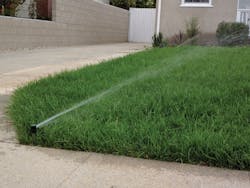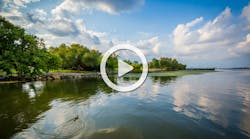About the author: Jacqueline McMillen, P.E., is water resources project manager and senior consultant for Alta Environmental. McMillen can be reached at [email protected] or 562.495.5777.
With the increasing focus on storm water capture and reuse throughout California—encouraged by the continuing historic drought—the benefits that arise from responsible management of storm water are well known. These benefits can include increased water supply reliability, improved water quality throughout a watershed, decreased flood risks, and protection and improvement of wildlife habitats and green space.
Yet, as the number of uses for storm water in non-potable systems increases, awareness of the potential unintended consequences that can result from the storage and reuse of storm water will become more important. Depending on storage conditions, storm water can potentially harbor pathogens such as Giardia, Cryptosporidium, Campylobacter, Legionella and rotavirus.
Threat of Legionella
Legionella may be of particular concern in storm water best management practices (BMPs) based on where the bacteria grows and its typical exposure pathway. Legionella is a type of bacteria found naturally in freshwater, including man-made or natural water systems. The bacteria thrive in warm water ranging in temperature from 68°F to 122°F. Legionella can persist in biofilm, which often can be found inside rainwater storage tanks, drainage piping with stagnant water, and storm water retention ponds. People are exposed to Legionella when they inhale small, aerosolized droplets of water that contain the bacteria and can result in either Pontiac Fever or Legionnaires’ disease. While not everyone exposed to Legionella will become sick, the Centers for Disease Control and Prevention estimates 8,000 to 18,000 legionellosis hospitalizations occur each year in the U.S., with up to a 30% fatality rate.
The typical exposure pathway for Legionella historically has not been a concern for storm water; however, storm water BMPs and new uses that aerosolize captured storm water may foster biofilm development and could potentially pose a risk for Legionella exposure. These BMPs and reuse activities include, but are not limited to:
- Retention basins with fountains, waterfalls or other water features;
- Irrigation using captured storm water; and
- Non-potable uses of captured storm water, such as toilet flushing or car washing.
Developing Guidelines
Recycling storm water for reuse in non-potable applications is not a new idea, but has gained more attention recently, particularly in areas experiencing extreme drought, such as California and Australia. While the U.S. Environmental Protection Agency has yet to develop any guidance or rules regarding the management of risks associated with Legionella in storm water treatment, reuse and recycling, there are existing standards and guidelines that address the risk of Legionella in building water systems.
In June 2015, ASHRAE published ANSI/ASHRAE Standard 188-2015, Legionellosis: Risk Management for Building Water Systems. The purpose of Standard 188 is to establish minimum legionellosis risk management requirements for building water systems, which, by definition, include potable and non-potable water systems in buildings or on building sites. Since it was published, Standard 188 has been considered a regulation-ready American National Standards Institute standard, and local regulatory bodies likely will begin making it a requirement. For example, the New York City Council voted to require adherence to Standard 188 just two months after it was published in response to a legionellosis outbreak.
Even if local governments do not adopt Standard 188 into their regulations, it still is reasonable for designers, owners and operators of building water systems to follow the recommendations of the standard because it provides a reasonable approach for avoiding risks associated with Legionella exposure.
Improper management of rain barrels may lead to the development of biofilm, which can harbor bacteria.
Analyzing Risks
Compliance with Standard 188 involves analyzing building water systems to determine if a project contains devices or factors that relate to legionellosis. Storm water BMPs could potentially represent such devices if they release water aerosols, such as in retention ponds with water features or in the use of storm water for irrigation. According to Standard 188, if risk factors for legionellosis are identified, it is recommended that responsible parties:
- Develop a water management program team;
- Create a flow diagram for all water system components;
- Conduct a detailed analysis of the water system;
- Monitor the key control para-meters that increase risk for
- legionellosis; and
- Take corrective actions whenever the measured values are not within the established limits.
The Australian government has gone a step further, specifically addressing the potential health risks associated with storm water by developing the “Australian Guidelines for Water Recycling: Stormwater Harvesting and Reuse,” published in July 2009. These guidelines use a risk-based management approach to provide guidance on managing potential public health and environmental risks associated with the reuse of roof water from non-residential buildings and urban storm water from sewered areas.
The quantitative assessment of microbial health-based risks described in the guidelines requires identifying the pathogens that are likely to be present in storm water, determining the likelihood of illness, estimating the level of exposure and assigning a risk value. The guidelines rely on three reference pathogens (Cryptosporidium, Campylobacter jejuni and human rotavirus) that are considered adequate to represent health risks associated with other pathogens, including Legionella.
Additionally, the state of Western Australia prepared a document titled “Draft Alternate Water Supply Guidelines – Stormwater and Rainwater,” which outlines specific precautions that can be taken to manage the risk of Legionella in storm water. These include avoiding storm water storage in hot weather, controlling the aerosolization of storm water, using personal protective equipment to avoid direct inhalation of aerosols and limiting storage of storm water to less than 24 hours. If there is any doubt as to the safety of the storm water, the water should be disinfected, tested for Legionella, discarded and not used for any purpose.
Storm water harvesting and reuse may pose health risks from Legionella exposure, similar to the known risks of potable water systems. It is vitally important to consider the potential risks, along with the benefits, as the use of storm water for non-potable activities continues to grow. Guidance specifically for storm water BMP implementation and management is needed to ensure protection of public health from Legionella and other possible health risks associated with storm water reuse.


